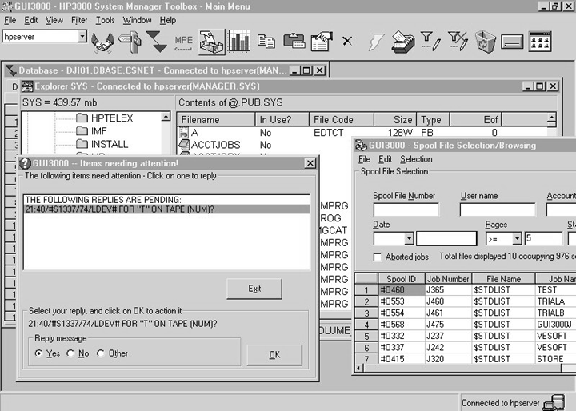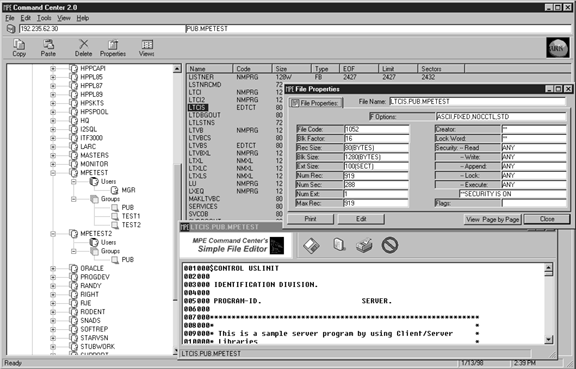
Click here for Robelle sponsor message
MPE goes GUI with Windows
interfaces
OMNISolutions, Bradmark tools put
graphical interface on HP 3000 management
OmniSolutions
( 800.935.0101) and Bradmark
(800.621.2808) are both introducing a graphical look for MPE
software this summer, although the OmniSolutions release is the
se-cond version of its GUI3000 tool. Bradmark leverages
work that
was begun with its Starvision middleware project to introduce
its MPE Command Center. Both products hope to make HP 3000
management
benefit from point-and-click advantages, giving MPE/iX a
makeover
much as Windows transformed the ugly duckling of DOS.
Both products benefit from the increased acceptance of
graphical
interfaces as controls for complex environments. GUI3000 first
introduced itself in early 1997 as a Windows Explorer-like
utility
for MPE, using a client on a Wintel system talking to an HP
3000
server job. MPE Command Center enters the field with a similar
structure but different features, including the ability to
manage
alarms from user-written applets and a way to launch Reflection
sessions for 3000 applications. To counter in the feature
comparison,
GUI3000 is set to have a version ready this month that enables
users to access IMAGE database files using a Berkeley Sockets
connection, skipping over the need for ODBC middleware or SQL
administration.
Officials at Bradmark believe that a graphical interface
can help
make the HP 3000 more attractive to managers who are unfamiliar
with the system. “This will help HP acquire new
business for the
3000,” said president Brad Tashenberg. “The
appearance of the
operating environment is going to be very much the look and
feel
that these younger new users want to see when they evaluate the
3000.”
Installed-base HP 3000 customers are bound to look at
the new
interface solutions differently, considering the effort many of
the customers have made to get comfortable with administration
through a command line. Current 3000 sites see the tools as a
way to get more work done in less time from the same desktop as
their corporate browsers and Windows-based screens.
Going GUI to databases, MPE
OmniSolutions’ GUI3000 is getting a second
generation release
this summer from Pete Vickers, the creator of the GUI tool for
MPE/iX management (See our March 1997 TestDrive for details).
Vickers said the  release, expected to be available
in a demo version 3 downloadable
in mid-June, will add a number of new features to the
administration
utility, most notably the ability to retrieve IMAGE data
for use
in desktop applications.
release, expected to be available
in a demo version 3 downloadable
in mid-June, will add a number of new features to the
administration
utility, most notably the ability to retrieve IMAGE data
for use
in desktop applications.
Users will be able to see all data items in IMAGE
datasets, which
can be protected with standard IMAGE password security for
datasets
and data items. The software lets users select data using
criteria
and recognizes Omnidex keys, resulting in records retrieved
into
an Excel-like client running on the PC. The data is also
downloadable
as CSV files, which can be imported into Excel and other PC
tools.
The database browsing selections use either key or
non-key items,
and include an option that allows administrators to limit the
number of records a user is allowed to search.
GUI3000’s database
browser is read-only.
GUI3000 will also link to Adager for database management in a future release, Vickers added, providing another graphical interface for the well-known IMAGE tool. OmniSolutions is also working on a way to link GUI3000 with Robelle’s Qedit for Windows, but in the meantime the company ships the product with a simple editor for manipulating files. It also supports StreamX and Security /3000 from Vesoft and launches Windows applications from the GUI3000 interface.
The product supports Vesoft’s MPEX commands from a utilities window, the method GUI3000 uses to handle commands of the 3000 Command Interpreter for which it doesn’t have standard GUI buttons, clicks or mouse actions. This window saves a user’s 50 favorite commands for one-click execution.
“Syntax errors are a thing of the past, since
GUI3000 command
window can be pre-programmed to handle the most complex MPE or
MPEX command,” said OmniSolutions’ Simon Tsalyuk.
GUI3000 provides graphical reports on capacity of IMAGE
databases
and disk space occupied by groups and accounts. Disk space
reports
on available and used space, totals, and by device.
GUI3000 is multiuser and operates across multiple 3000s;
it doesn’t
require sessions on
the HP 3000. It will print from its File Explorer and Database
Explorer modules, and can stream and schedule jobs from
File Explorer.
A Spoolfile Explorer lets users search for spooled jobs by
attributes,
including date printed and size of job, printing jobs on local
PC printers. Another feature of the product monitors and
reports
on outstanding replies from applications or jobs.
Command Center launches
If GUI3000 leans heavily into exploring HP 3000
contents, MPE
Command Center offers a way to keep users away from command
lines
with MPE Launcher, its launch facility for 3000 applications.
The facility invokes WRQ’s Reflection to start a
session with
any HP 3000 application, a feature that appears to serve
the product’s
design objective of integration.
“Bridges have to be put in place between systems,” said Bradmark’s Tashenberg. “This is a continuum on the integration path for the HP 3000, putting it together from a top-down methodology.”
 Command Center also works to give MPE
administrators control of
systems from a single console, Tashenberg added.
“It’s a virtual
console – any PC can become the command center,”
he said. The
product offers performance monitoring at the CPU usage and IO
level. It also tracks alarms and alerts which can be generated
by user-written applets written in object-oriented designs with
FORTRAN, C or Java.
Command Center also works to give MPE
administrators control of
systems from a single console, Tashenberg added.
“It’s a virtual
console – any PC can become the command center,”
he said. The
product offers performance monitoring at the CPU usage and IO
level. It also tracks alarms and alerts which can be generated
by user-written applets written in object-oriented designs with
FORTRAN, C or Java.
“We’re trying to develop a methodology for
them to go to any level
they want, to develop these and hook right into our
structure,”
Tashenberg said.
Database monitoring for Command Center will come from
whatever
utilities are already running in the HP 3000 environment,
including
Bradmark’s own DBGeneral as well as Adager.
“If we had a Windows front end to the utility, it could be brought up as a Windows function,” Tashenberg explained of his own product. But DBGeneral’s IMAGE/SQL version operates as a character-driven application, “and Adager could be brought up the same way. We’re trying to identify whatever the user has as a suite of utilities, and allow them the flexibility to bring those utilities up.
“We’re just trying to build a structure that
makes what they have
in place easier to use,” he said. “You’re
looking at the 3000
as a virtual machine and the enterprise as the whole
machine.”
While MPE Command Center covers only networked 3000s and
the clients
attached to them today, Tashenberg said the product will
ultimately
have the same reach as the open systems version of DBGeneral,
designed to manage a variety of non-IMAGE databases on multiple
platforms.
Samba and similarities
There’s a baseline of interface functionality that products like this need to provide, often measured by the abilities of management tools users have come to expect from Microsoft utilities like File Manager and Explorer: viewing files in any order by sorting files in ascending or descending order of attribute, and the ability to purge, copy and rename groups of files at a stroke. Like its competitor from Bradmark, GUI3000 can manage files, groups and accounts and provides an interface to the HP 3000 for carrying out commands. Both products create and modify groups and accounts, performing drag-and-drop copying between HP 3000s and between the 3000 and PCs.
This ability to drag files for copying between 3000s and PCs is on the way in this summer’s MPE/iX 6.0 release through Samba/iX. Bradmark’s Tashenberg said that MPE Command Center understands MPE filecodes and spoolfile management and Samba doesn’t, features that GUI3000 also understands.
The MPE specifics set these tools apart from software created for multiple platforms. “Samba is an NT operating system imposed on the 3000,” Tashenberg said. “We’re trying to develop a Windows version of MPE. We’re not interested in keeping the same look and feel of an NT operating system. We’re trying to elevate MPE.”
Until July, GUI3000 is priced at $1,200 for Series 9x9
and 99X
systems, licensed for a single HP 3000, and $950 for other HP
3000s. MPE Command Center is priced in user tiers and
server tiers,
starting at $1,500 for an 8-user license and $7,000 for a
64-user
license on a Series 995.